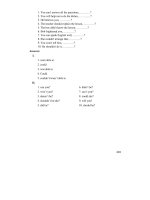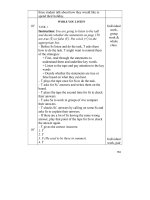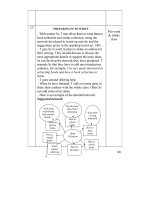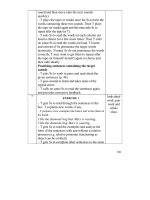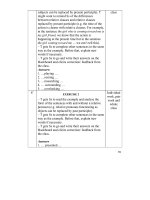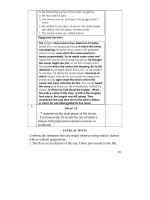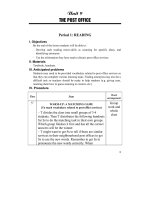bài giảng tiếng anh 11 unit 11 sources of energy
Bạn đang xem bản rút gọn của tài liệu. Xem và tải ngay bản đầy đủ của tài liệu tại đây (1.89 MB, 27 trang )
1.What source of energy does each
picture above refer to?
Wind energy Solar energy
Water energy
2. What do we need energy for?
-> We need energy to cook meals, to light, heat or cool the house and to
run machines…
Oil, petrol, coal and gas are fossil fuels
fossil fuels: nhiên liệu hoá thạch-
Limit / ˈlɪmɪt/ (v) :to restrict or reduce the amount of
something that you or somebody can have or use.
-
Limit (n) : a point at which something stops being
possible or existing .
Ex:There is a limit to the water we can use .
-
Limited /ˈlɪmɪtɪd /(adj): not very great in amount or
extent: có hạn.
Ex: Our natural sources of energy are limited.
-
Limitation / ˌlɪmɪˈteɪʃn/ (n): the act or process of
limiting or controlling somebody/something.
Is there a limit to the amount of the natural sources of
energy ?
Are our natural sources of energy limited or unlimited ?
Hydroelectric dam: Đập thủy điện
/ˌhaɪdrəʊɪˈlektrɪk/ /dæm/
-
Electric /ɪˈlektrɪk/ (adj) : connected with
electricity;using or produce electricity (liên quan
đến điện.
-
Electrical /ɪˈlektrɪkl/ (adj)
-
Electrically /ɪˈlektrɪkli/ (adv)
-
Electrician /ɪˌlekˈtrɪʃn/ (n) :a person whose job is
to connect, repair, etc. electrical equipment
-
Electricity /ɪˌlekˈtrɪsəti / (n) : điện,điện lực.
Ex: Her electricity was cut off when she didn’t pay
her bill.
Do we need to save electricity?
What do we do to save electricity?
Windmill :
/ˈwɪndmɪl /
a tall thin structure with parts that turn round,
used to change the power of the wind into
electricity (cối xay gió).
Solar panel: Tấm thu năng lượng mặt trời
/ˈsəʊlə(r)/ /ˈpænl/
Nuclear :
nuclear reactors
nuclear bomb
Nguyên tử
/ˈnjuːkliə(r)/
geothermal heat: Địa nhiệt
/ˌdʒiːəʊˈθɜːml/ /hiːt/
-
Release /rɪˈliːs/ (v) : let sb/sth free (phóng thích)
Ex: Large amounts of energy are released by the sun
everyday.
-
Release (n) : sự phóng thích,sự giải phóng.
1. fossil fuels (n): 5. Windmill
2.limit (v) 6. Solar panel
limit (n) 7. Nuclear
Limited (adj) nuclear reactor
Limitation(n) nuclear bomb
3. Hydroelectric dam 8. geothermal heat
4. Electric(adj) 9. Release (v)
Electrical (adj) release (n)
Electrically (adv)
Electrician(n)
Electricity (n)
Read the passage and then do the tasks that follow
At present, most of our energy comes from fossil fuels (oil,coal,and natural gas). However , such
reserves are limited. Because power demand is increasing very rapidly, fossil fuels will be
exhausted within a relatively short time. Therefore, people must develop and use alternative
sources of energy.
One alternative source is nuclear energy. Nuclear energy can provide enough electricity for the
world’s needs for hundreds of years, but it can be very dangerous. Another alternative source
of energy is geothermal heat, which comes from deep inside the earth. Scientists use this heat
to make energy. However, this energy is available only in a few places in the world.
The sun, water, and the wind are other alternative sources of energy. The wind turns windmills
and moves sailboats. It is a clean source of energy, and there is lots of it. Unfortunately, if the
wind does not blow, there is no wind energy. When water moves from a high place to the
lower place, it makes energy. And as dams cost a lot of money, so water energy is expensive.
The sun releases large amounts of energy every day. This energy can be changed into electricity .
Many countries use solar energy for their daily life. Solar panels on the roofs of houses can
create enough energy to heat or cool an entire house. Solar energy is not only plentiful and
infinite but also clean and safe.
Although there are some disadvantages, the potential of alternative sources of energy is great .
However, how to make full use of these sources of energy is a question for researchers all
over the world.
How many sources of energy are mentioned in
the text? What are they?
Task 1
Find out in the text the words which means:
1. energy obtained from the power of the sun,
wind, water:
2. to give out:
3. With end:
4. power:
5. use until it is completely finished:
alternative
release
limit
energy
exhausted
TASK 2: Scan the passage and write down the advantage (s) and
disadvantage (s) of each alternative source of energy.
Sources of energy Advantage(s) Disadvantage(s)
Nuclear power
Geothermal heat
Wind power
Water power
Sources of
energy
Advantage(s) Disadvantage(s)
Nuclear energy
Geothermal heat
Paragraph 2
Nuclear energy can provide enough electricity for the world’s needs
for hundreds of years, but it can be very dangerous. Another
alternative source of energy is geothermal heat, which comes from
deep inside the earth. Scientists use this heat to make energy.
However, this energy is available only in a few places in the world.
It’s plentiful
It can be very
dangerous
available in only a
few places
It is available
Paragraph 3
The wind turns windmills and moves sailboats. It is a clean
source of energy, and there is lots of it. Unfortunately, if the wind
does not blow, there is no wind energy. When water moves from
a high place to a lower place, it makes energy. This energy is
used to create electricity. Water power gives energy without
pollution. However, people have to build dams to use this energy.
And dams cost a lot of money, so water energy is expensive.
Sources of
energy
Advantage(s) Disadvantage(s)
wind power
water power
It’s clean, plentiful,
infinite
If the wind does not
blow, there is no wind
energy.
It’s clean,
plentiful, infinite
expensive
Sources of
energy
Advantage(s) Disadvantage(s)
Nuclear power It’s plentiful It can be very
dangerous
Geothermal heat It is available available in only
a few places
Wind power It’s clean, plentiful,
infinite
If the wind does not
blow, there is no
wind energy.
Water power It’s clean, plentiful,
infinite
expensive
TASK 2: Scan the passage and write down the advantage (s) and
disadvantage (s) of each alternative source of energy.
Task 3: Read the passage and then decide
whether the statements are true (T) or false (F).
1. Our major source of energy comes from fossil
fuels.
2. The sun gives out large amounts of energy every
day.
3. Solar energy is plentiful, finite, ,unclear,unsafe.
4. The potential of alternative sources of energy
is very large.
T
T
T
F
infinite, clear,
safe
SOURCES OF ENERGY
1
ALTERNATIVE
SOURCES
oil 3
2
4
5
6
solar
energy
wind power
gas
coal
FOSSIL FUElS
nuclear
power
geothermal
heat
water
power
Task 4:Complete the summary of the reading passage by filling each
blank with a suitable word from the box.
one environment alternative limited
unlimited sources energy fuels
We need energy to live and work. Our major source of (1)
……….… is oil. Oil is (2)… … kind of fossil fuel. The
amount of fossil (3) .… …… in the world is (4) ……….…
Therefore, we must save it, and at the same time, we must find
new sources of energy. Geothermal heat and nuclear power
are (5) …… sources of energy. They can give us
electricity. Other alternative (6)……………are the sun, waves
and water. These sources are not only (7)……………. and
available but also clean and safe for the (8)…………………
People should develop and use them more and more in the
future.
one
fuels
limited
alternative
sources
unlimited
environment
energy


